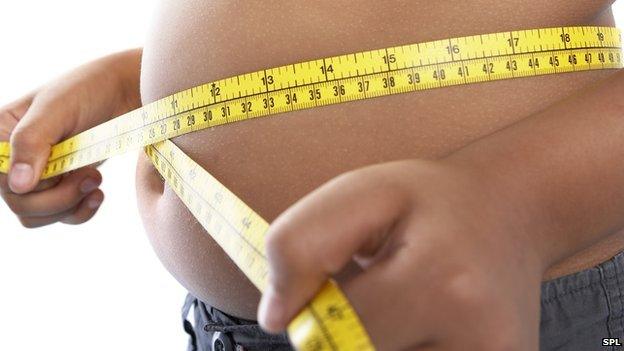Child obesity: Are 22,000 children 'severely obese'?
- Published

Almost 60% more children in their last year of primary school are classified as "severely obese" than in their first year, according to Public Health England figures for England and Wales.
The Local Government Association (LGA) said this shows children are becoming fatter as they go through school.
But what does "severely obese" mean?
Every year, Public Health England - part of the Department of Health and Social Care - measures children aged four and five, and children aged 10 and 11 in England. This year, for the first time, they included a "severely obese" category.
It defined severe obesity as children in the heaviest 0.4% of weights for their age.
For adults, healthy weight is determined using body mass index (BMI) - a calculation based on their height and weight. If you are over a fixed weight for your height, you will be considered obese.
But for children under 18, because they're still growing, their BMI is compared with a sample of heights and weights of other children their age and sex, to work out where they are compared with a typical child.
Public Health England, which is responsible for overseeing national programmes on obesity, uses a measurement known as the UK90, which is based on the measurements of British children and young adults from nought to 23 years old collected between 1978 and 1994.
They use these measurements from several decades ago in part to create a fixed point of comparison, so that while the population as a whole gets heavier, the threshold of what we consider healthy doesn't creep up.
Public Health England says that any child whose BMI is higher than 95% of measurements for their age and sex, according to the UK90, is obese.
A large representative sample of British children and young people were measured to work out a typical range of weights at each age. These weights where then divided into 100 equal bands or "percentiles". Any children in the 95th percentile of weights or above would be considered obese.
And those with measurements above 99.6% are "severely obese".
We know that last year, about 60,000 children at the end of primary school in England and Wales were obese, of whom 22,000 were classed as "severely obese".
What's harder to know is whether that's a fair cut-off point at which those children should be dubbed obese and considered at risk of ill-health.
Critics of the 95% measurement say it brands a group of children as obese unnecessarily.
Christopher Snowdon, at the Institute of Economic Affairs, says too many assumptions were being made which "exaggerate the scale" of the obesity problem and there's not enough evidence to suggest that after that cut-off point, children are actually "obese".
Paediatrician Dr Max Davie says: "No-one thinks it's the best or a perfect measure but it does correlate with the negative health outcomes associated with obesity."
Children with BMIs in the region of 90% and upwards are at higher risk of harm and, on average, the higher you go up the scale, the higher the risk of ill-health.
Dr Davie says although both the 95% and 98% cut-off points for obesity are somewhat arbitrary, they still serve as a useful tool.
It might not be the perfect measure of when an individual child is at risk of ill-health, but it does give a way of comparing populations over time and around the country, he says.
It's also a simple enough measure that it can be applied to the whole population.
In the NHS in England, doctors tend to use a slightly higher threshold than the Public Health England one - they say a child is obese if they are in the 98th percentile of weights.
But Public Health England says it uses a lower threshold in order to capture children who are at risk of becoming under or overweight or obese, as well as those who already fall into this category.
These are averages though - children develop at different rates, some may gain weight before a growth spurt in height, and there are ethnic differences too.